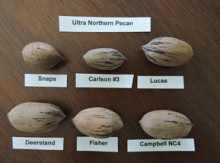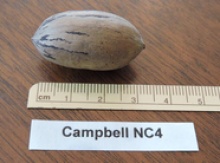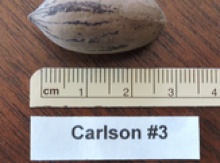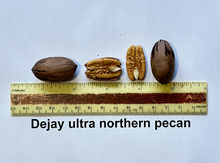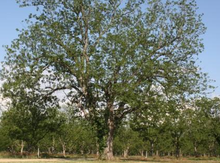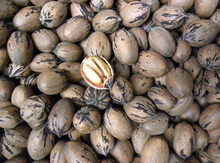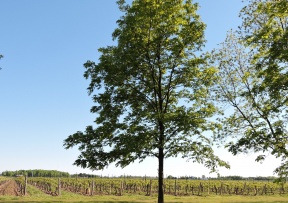
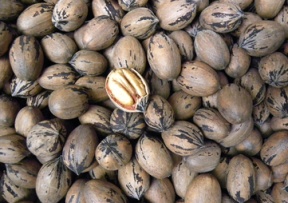
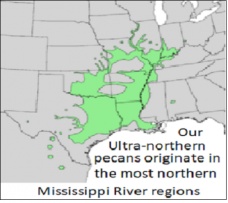
Pecan, Ultra Northern
John Gordon and Gary Fernald, two pecan enthusiasts, searched for the earliest ripening pecans at the northern end of the wild pecan range near the Mississippi River in Iowa and Missouri. Gordon brought back nuts and grafting wood for testing. The best of these were established in Ontario at our nursery test orchard and are available as seedling and grafted trees. And so, the Ultra-northern pecans became established as a distinct strain of pecan. The best ulta-northern pecans produce nuts the size of typical wild trees further south.
Our grafted trees are grown on 3 year old rootstocks in containers for two more years to encourage fibrous rooting for best transplant success and growth. In zone 5 and 6a, grafts need to be hilled up above the graft for the winter with garden soil like roses would need, to protect the cold-tender graft area. They do best with long hot summer conditions to fully fill the nutmeat, Tree size ranges from 20-22 m in height and 15 m wide (70 x 45 ft) at maturity.
Leafhoppers are a problem in the first 2 years with pecan trees. These sucking insects can cause the leaves to wrinkle and turn black on the edges. Spray with a fruit tree insecticide in late June and again in July for best results.
All of our seedlings are grown from our own grafted trees. They all ripen nuts in our climate. This makes sure that both parents are early ripening with a greater likelihood of passing on this desireable characteristic. These trees are as hardy as our hickory trees.Since they are seedlings, we cannot tell if they are protandrous (type 1) or protgynous (type 2) until they bloom and that can be 10 years after planting. We suggest planting 3-4 trees to be more certain of getting a type 1 and type 2 trees. Suited for zones 5b-8.
'Campbell NC 4' is an improvement over 'Colby', its parent, a northern pecan from Illinois. It was selected by Doug Campbell of the Niagara area. It is medium in nut size and good cracking. It ripens late October to early November for us and tends to bear good crops 2 out of 3 years. It is protandrous, that means that it opens pollen tassels before the female bloom. It should be matched with a protogynous cultivar that opens female blooms first. Suited for zones 5b-8.
'Carlson 3' is one of our earliest ripening cultivars but the nut is small. It was discovered in New Boston, IL. It is an annual bearer, ripening nuts along with the hickories in early to mid October. It cracks out in halves fairly well. Recommended for short season areas. It is protandrous, that means that it opens pollen tassels before the female bloom. It should be matched with a protogynous cultivar that opens female blooms first. Suited for climate zones 5-8.
'Deerstand' is a medium size nut ripening near the end of October. It was discovered in the wild at Green Island, IA. It is a productive tree but tends to have a good crop every 2 out of 3 years. It is a well-filled good cracking nut. The tree is very hardy originating from the wilds of Green Island, Iowa along the Mississippi River. It is protogynous, that means that it opens female flowers before the male catkins are shedding. It should be matched with a protandrous cultivar that opens male catkins first. The nuts ripen and drop late season for us.and that is from late October to early November. Suited for zones 5b-8.
'Dejay' ultra-northern pecan was introduced by John Gordon, a renowned nut tree explorer who along with Gary Fernald, spent several years exploring along the Green Island area of the Mississippi River to find new pecan selections for propagation in more northern climates. Dejay was a selection Gordon made on his Amherst, NY farm where he planted thousands of seedlings brought back from his explorations. Dejay was so named because he facetiously considered that the nut was big enough to deter the blue jays that fed on pecans. Nut size is similar to Deerstand and Campbell NC4 as well as most native ‘northern’ pecans in the south. It is mid season ripening. Suited for zone 6-9.
'Fisher' is similar to 'Lucas' in characteristics, ripening about the same time. I was introduced from New Memphis, IL. It is protogynous, that means that it opens female flowers before the male catkins are shedding. It should be matched with a protandrous cultivar that opens male catkins first. The nuts ripen and drop mid seaon from us, that is, about October 15-30. Suited for zones 5b-8.
'Lucas' is a good producer of medium size nuts. The tree was discovered in Ohio. The nuts fill well, are good cracking and ripen late October. It is protandrous, that means that it opens pollen tassels before the female bloom. It should be matched with a protogynous cultivar that opens female blooms first. Lucas ripens mid season for us. Suited for zones 5b-8.
‘Missouri’ is the new name for ‘Warren 317’. Named for its place of origin. The tree has been annually productive. Similar to ‘Warren’, the nuts are well filled and ripen mid to late October in Niagara. Suited for zones 5b-8.
'Snaps' is one of our earliest ripening cultivars but the nut is small for us. In more southern warmer climates (zone 7b-8b), the nut is larger. It was discovered in the wild at Pleasant Creek, IA. It is an annual bearer ripening nuts along with the hickories in early to mid October. It cracks out in halves fairly easily. It is protandrous, that means that it opens pollen tassels before the female bloom. It should be matched with a protogynous cultivar that opens female blooms first. Recommended for short season areas. Suited for climate zones 5-8.
'Warren' formerly 'Warren 346' is from a commercial orchard in Wheeling Missouri. Mr. Warren was kind enough to select and distribute 2 selections #346 and #317. They were selected for earliness of ripening, hardiness, productivity and nut cracking qualities. It ripens mid season for us or mid to late October depending on the summer conditions..The nut size is in the size range of the native pecans from the mid-west. They have proven to be among our best selections. It is protandrous, that means that it opens pollen tassels before the female bloom. It should be matched with a protogynous cultivar that opens female blooms first. Suited for zones 5b-8.



